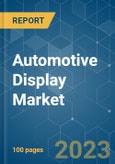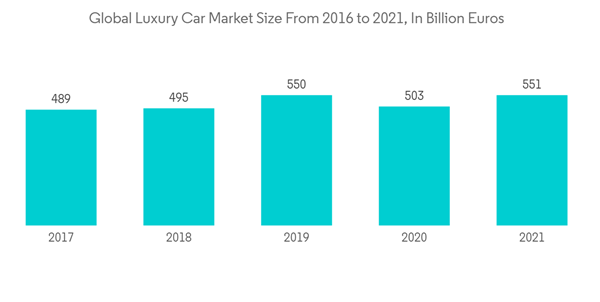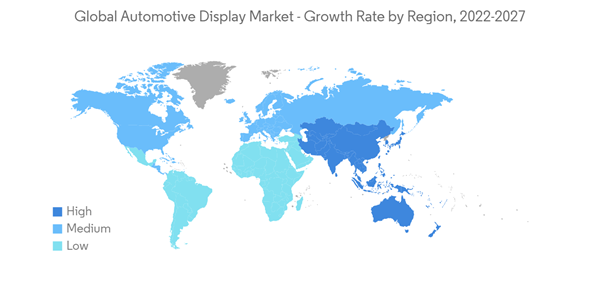The automotive display market was valued at USD 11.9 billion and is expected to reach USD 17.3 billion, registering a CAGR above 6.41% during the forecast period.
In January 2022, Visteon announced the launch of a fourth-generation smart core cockpit domain controller for enhanced safety and connected mobility. The smart display offers seamless support of multiple displays along with integrated infotainment, safety, and security features. The smart display comes with artificial intelligence-based speech recognition and camera-domain integration.
In November 2021, Continental AG technology company earned its first major order for OLED displays in a production vehicle from a global vehicle manufacturer. The multi-display stretches from the driver’s area to the center console and integrates two screens, which are optically bonded behind a curved glass surface. Production of the display solution is scheduled to start in 2023.
This product will be delivered within 2 business days.
Key Highlights
- The recent COVID-19 has disrupted market growth. With lockdowns and travel restrictions, the demand for vehicles declined. As a result, the growth of automotive parts of the automotive industry also declined in the past two years. This trend is seen in all segments related to the automotive industry. However, post-pandemic,, as the situation is improving, the companies are focusing on developing new products that suit the customers' demands.
- For instance, in November 2022, Marelli Corporation updated its featured technology portfolio. 'Digital Design Studio' by Marelli will be on display. In addition to the Smart Surface solution, the company will launch the Horizon Head-Up Display, which projects navigation, indicator, and warning information close to the bottom edge of the windshield, allowing objects in the driver's blind spot to be easily recognized.
- Over the long term, the market is primarily driven by technological advancements and innovations in various vehicle display systems such as infotainment, telematics, instrument cluster, etc. In developed nations, rising consumer preference toward driving convenience and safety is driving the market’s growth. Further, with an increased need for vehicle safety features, technologies such as augmented reality have turned from a mere concept into reality. Many luxury car brands, such as BMW, Jaguar, and Mercedes-Benz, have already implemented AR head-up displays and brought real-time gaming experiences.
- For instance, in October 2022, AirConsole and the BMW Group announced a collaboration to integrate casual gaming into new BMW vehicles. AirConsole is a gaming platform that works perfectly with the BMW Curved Display and has a large and diverse game catalog.
- With the growing sales of passenger cars, the rising demand for connected vehicles, and a high disposable income, the automotive display market has been witnessing rapid growth, particularly in Asia-Pacific. Moreover, the region is expected to dominate the market due to the increasing sales of luxury cars such as Mercedes-Benz, Audi, Porsche, BMW, and Jaguar Land Rover. Therefore, the automotive display players focus on developing displays for automakers' needs.
- For instance, in December 2022, Faurecia Clarion Electronics, a subsidiary of the Forvia Group, stated that the company would focus on developing large, irregular displays. The company will create high-value-added products to meet automakers' needs.
Automotive Display Market Trends
Increasing Demand of OLED Displays in the Luxury Vehicle is Expected to Witness Faster Growth Rate
- The rising demand for luxury vehicles in developing countries is expected to fuel the automotive display system market. The luxury car market segment is expected to grow at a rate ranging from 8 to 14 per cent per year during the forecast period. In India, Mercedes-Benz, BMW, and Audi are the top luxury car manufacturers. These car manufacturers collectively reported sales of around 22,500 units in 2021.
- Luxury car manufacturers such as Lexus, Audi, and others have integrated technologically advanced display systems into their vehicles. For instance, in October 2022, Cadillac unveiled the Celestiq, its handcrafted, all-electric flagship. The vehicle's large, 55-inch-diagonal advanced HD screen is one of five high-definition displays, with rear passengers having their 12.6-inch-diagonal advanced displays.
- Technology has advanced to the point where it is cost-effective, such as thin-film-transistor liquid-crystal display (TFT-LCD) and organic light-emitting diode (OLED), which aids in the enhancement of display resolution and features. Furthermore, it is useful in map navigation and multimedia options, which will likely drive demand for automotive display systems. OLED panels are gaining popularity in the luxury car market owing to their high flexibility in design and growing demand from original equipment manufacturers (OEMs) in their new model launches. For instance, Currently, Active Matrix OLED (AMOLED) screens are being used mostly for rear seat entertainment in luxury cars.
- However, to reach automotive-grade specifications, AMOLED material and display costs are expected to be high. This is expected to slightly hinder the market’s growth. With the evolvement of intelligent connectivity technology, cars will be mobile smart terminals. In addition to cluster & center console dual displays, HUD, electronic rearview mirror displays, copilot recreation displays, rear seat entertainment displays, and transparent A-pillars have emerged.
- Moreover, according to the concept models released by Oz EMs, curved displays will shine in the automotive display field in the future. Luxury brand cars and new energy vehicles are now making use of OLED displays. Previously, they only used small displays such as transparent A-pillars, and Audi virtual rearview mirror displays. Such developments are likely to enhance the demand for displays in the market during the forecast period.
Asia-Pacific Expected to Capture Significant Market Share During the Forecast Period
- Asia-Pacific is expected to see faster growth in the market studied, owing to the increasing adoption of rear seat entertainment displays in taxis as well as display manufacturers have been focusing on the production of OLED technology.
- In India, automobile production has increased; Passenger car production has increased from 3,062,280 units in 2020-21 to 3,650,698 units in 2021-22. On the other hand, Commercial Vehicles production has increased from 624,939 units in 2020-21 to 805,527 units in 2021-22. Major taxi aggregators like Uber and Ola have been significantly installing rear seat entertainment display panels in their premium and luxury taxi cabs over the past two years to attract customers' attention and booking preferences.
- Automotive display manufacturers like Visionox in China will be providing Zhejiang Hozon New Energy Automobile Co., Ltd. (Hozon) with intelligent cabin display products featuring centre information display (CID) systems, dashboards, head-up display instruments, and rear seat entertainment display instruments for autonomous New Energy Vehicles (NEVs). These displays are manufactured based on advanced organic light-emitting diode (OLED) technology. Moreover, key players in the other Asia-Pacific countries are also installing the advanced display system in their vehicles which is also expected to play a dominant role in the market growth.
- In October 2022, Mazda Sale Thailand introduced four special models under the brand name Carbon Edition, each with its personality. The Mazda3 Carbon Edition 4-door sedan features black alloy wheels and a 360-degree image display system.
- Therefore, all the above-mentioned developments and advancements in the market will likely contribute to the holistic development of the Asia-pacific region over the forecast period.
Automotive Display Market Competitor Analysis
The automotive display market is moderately consolidated as the presence of some of the key major players, like Continental AG, Visteon Corporation, Panasonic Corporation, Denso Corporation, Robert Bosc GmbH, etc., have captured significant shares in the market. With companies focusing on product innovation and technology advancement, the automotive display business is experiencing high competition in the global market.In January 2022, Visteon announced the launch of a fourth-generation smart core cockpit domain controller for enhanced safety and connected mobility. The smart display offers seamless support of multiple displays along with integrated infotainment, safety, and security features. The smart display comes with artificial intelligence-based speech recognition and camera-domain integration.
In November 2021, Continental AG technology company earned its first major order for OLED displays in a production vehicle from a global vehicle manufacturer. The multi-display stretches from the driver’s area to the center console and integrates two screens, which are optically bonded behind a curved glass surface. Production of the display solution is scheduled to start in 2023.
Additional benefits of purchasing the report:
- The market estimate (ME) sheet in Excel format
- 3 months of analyst support
This product will be delivered within 2 business days.
Table of Contents
1 INTRODUCTION
4 MARKET DYNAMICS
5 MARKET SEGMENTATION (Market Size by Value - in USD billion)
6 COMPETITIVE LANDSCAPE
Companies Mentioned (Partial List)
A selection of companies mentioned in this report includes, but is not limited to:
- Denso Corporation
- Robert Bosch GmbH
- Visteon Corporation
- Continental AG
- Harman International Industries, Inc.
- Magneti Marelli SpA
- Panasonic Corporation
- Yazaki Corporation
- LG Display Co.
- Nippon Seiki Co. Ltd
Methodology

LOADING...










